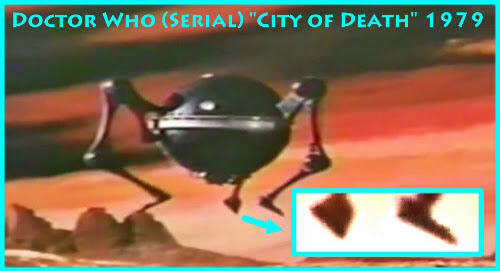Reality is boring.
There are so many better ways to explain the wedge of Aiud, and the BBC provided one over thirty years ago. If we going to confuse reality with make believe - there is an episode of Doctor Who called "City of Death" where a member of the Jagoroth called Scaroth is splintered through time when his VTOL spaceship explodes 400 million years ago as he attempts to take off using "Warp Drive". (There's no information provided on the alloy make-up of Scaroth's ship.) The multiple Scaroths work to create a time machine to return to the distant past and stop himself from taking off. This paradoxical plan is financed by stealing artwork in the past; having Leonardo Da Vinci paint another half-dozen Mona Lisas and selling them in the present.
Now that's interesting.
 |
| Still from Doctor Who "City of Death". Notice a striking similarity between the feet of Scaroth's ship and the Wedge of Aiud. |
Notice that the landing gear on the Jagoroth ship (a creation of BBC special effects!) bears a striking resemblance to the Wedge of Aiud - more-so than the original "aeronautic engineer"'s drawing. Does that mean that Douglas Adams' story is actually based on real events, or that real events are based on a story? Neither. The BBC story and the "true" story of the Wedge simply involve the use of creativity to fill in gaps in knowledge - and a marked indifference to inconvenient facts such as the increased corrosion rate for Aluminum - Copper alloys or paradox involved in Scaroth changing his past.
Really, if there's evidence of Aliens in the archeological record, don't just infer it. Show us a phaser. Show us a Tribble. Show us a Gorn. In situ. Not something that fell off the machine digging the hole in the first place.


Ha! It's just embarrassing how people abuse science to try and prove their fantasies are real. Fantasies are way more enjoyable in literature and on TV. I like how you set this all up. Excellent blog.
ReplyDelete